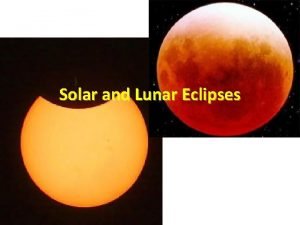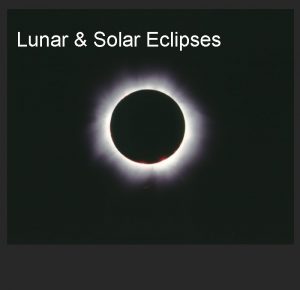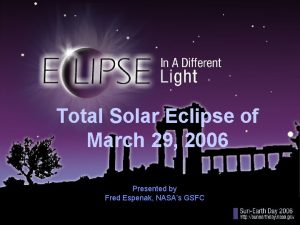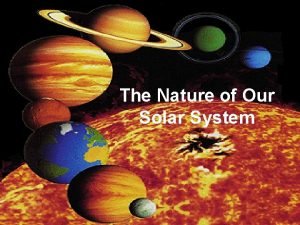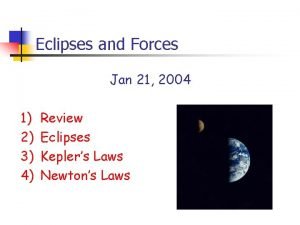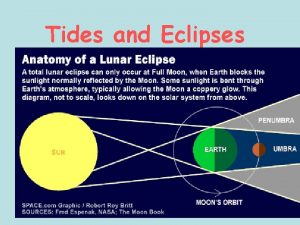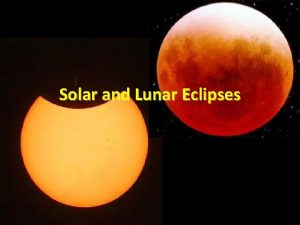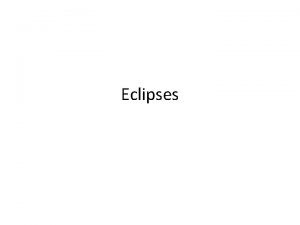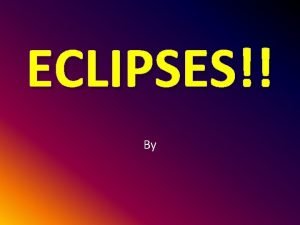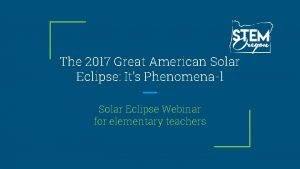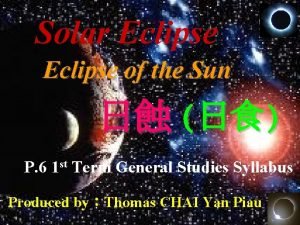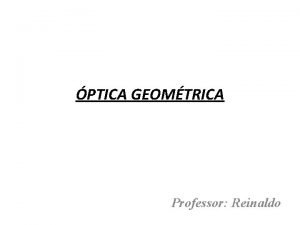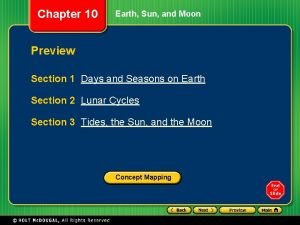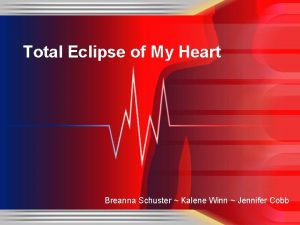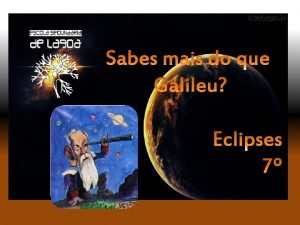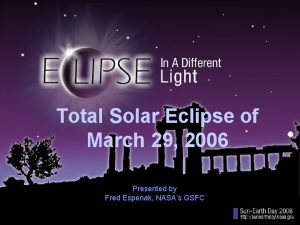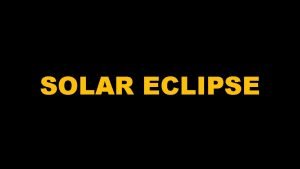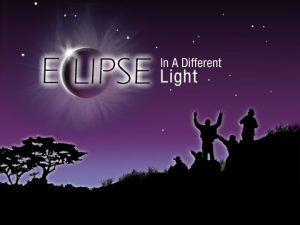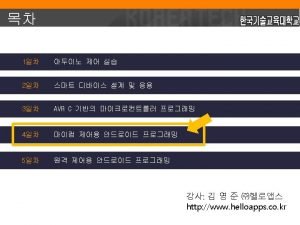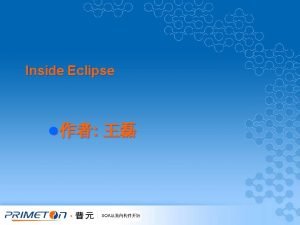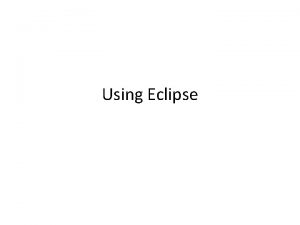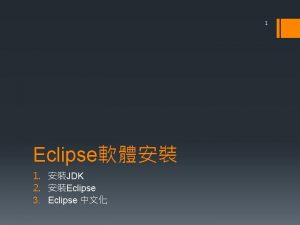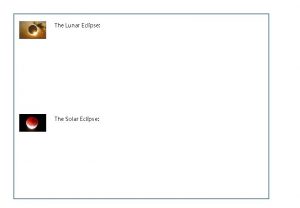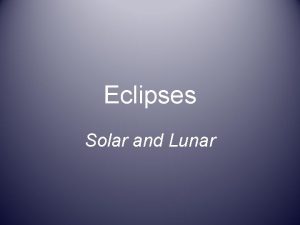title Total Solar Eclipse of March 29 2006


































- Slides: 34

title Total Solar Eclipse of March 29, 2006 Presented by Fred Espenak, NASA’s GSFC

Earth and Moon: Moon Solar Full Eclipse Geometry 1 To Sun Full Moon Earth The Moon orbits Earth once every 29. 5 days with respect to the Sun To Sun

Earth and Moon: Moon Solar New Eclipse Geometry 2 To Sun New Moon Earth The Moon orbits Earth once every 29. 5 days with respect to the Sun To Sun

Earth and Moon: Eclipse Geometry Solar Eclipse Geometry 3 To Sun Penumbra New Moon Umbra Earth An eclipse of the Sun is only possible during the New Moon phase. To Sun

Earth and Moon: Eclipse Path Solar Eclipse Geometry 4 To Sun Penumbra New Moon Umbra Earth Path of Totality During a total solar eclipse the Moon’s two shadows sweep across Earth. To Sun

Partial Phases of a Total Solar Eclipse Every total eclipse begins with a series of partial phases which may last an hour or more. However, the total phase or “totality” never lasts more than 7. 5 minutes. This time series photo shows an entire total solar eclipse, from start to finish over a period of over two hours. Credit: Dennis Mammana

Astronomy Picture of the Day - August 13, 1999 Credit: E. Israel Eclipse Shadows When sunlight passes through gaps between leaves of a tree, the shadows on the ground show little images of the eclipse happening in the sky above. This is the same principle as the pinhole camera.

Astronomy Picture of the Day - June 21, 2001 Credit: Fred Espenak “Diamond Ring” Effect Before Totality Begins In the last seconds before totality begins, the remaining bit of Sun resembles a dazzling jewel as the ring-like corona appears.

Total Solar Eclipse Video of the June 21, 2001 eclipse in Africa shows the Diamond Ring Effect as the Sun vanishes behind the Moon and Totality begins. Click on image to play video

The sun’s glorious corona is composed of hot, rarified plasma with a temperature of 1 to 2 million degrees Centigrade. It is only visible during a total eclipse when the Moon hides the Sun’s brilliant disk. Astronomy Picture of the Day - Sept. 15, 1999 Credit: Fred Espenak Glorious Solar Corona

During “totality” the landscape is bathed in an eerie twilight. Bright stars and planets are visible. Astronomy Picture of the Day - 2003 January 08 Credit: Olivier Staiger Eerie Twilight During a Total Solar Eclipse

Astronomy Picture of the Day - August 30, 1999 Credit: Mir 27 Crew; Copyright: CNES Earth and Eclipse from Space From space, the Moon’s umbra can be seen sweeping over Earth during a total solar eclipse. Only observers within the shadow’s path will see “totality” - outside the path a partial eclipse will be seen.

It’s possible to see a total eclipse from anywhere on Earth. This image was shot in Antarctica in 2003. Astronomy Picture of the Day - 2003 December 08 Credit: Fred Bruenjes Total Solar Eclipse from Antarctica

Partial Solar Eclipse Partial Eclipse of Oct. 14, 2004 (Hawaii) Credit: Fred Espenak Partial eclipses are visible over a much larger part of Earth than total eclipses. So they are seen by many more people.

Annular Solar Eclipse The solar corona is NOT visible during an annular eclipse. The remaining ring of sunlight hides the corona in its glare. Annular Solar Eclipse of May 10, 1994 (Toledo, Ohio)

Frequency of Solar Eclipse Types Eclipses per Year: 2 to 7 Totals per Year: 0, 1 or 2 Partial Annular Total Hybrid Fred Espenak, NASA’s GSFC 35% 33% 27% 5%

Total Solar Eclipse of March 29, 2006

Total Solar Eclipse of 2006

Total Solar Eclipse of March 29, 2006

Total Solar Eclipse of March 29, 2006

Total Solar Eclipse of March 29, 2006

Total Solar Eclipse of March 29, 2006

Total Solar Eclipse of March 29, 2006

Total Solar Eclipse of March 29, 2006 Side

Total Solar Eclipse of March 29, 2006

Total Solar Eclipse of March 29, 2006

NASA Solar Eclipse Bulletins §Bulletin for all Major Solar Eclipses – All Total & Some Annular §Published 12 -24 months before eclipse §NASA’s 2006 Eclipse Bulletin (on web): – umbra. nascom. nasa. gov/eclipse/ 20060329/rp. html §NASA’s 2006 Eclipse Bulletin pdf): �( – sunearth. gsfc. nasa. gov/eclipse/S Epubs/TP 212762. html §NASA’s 2006 Total Solar Eclipse Website: – sunearth. gsfc. nasa. gov/eclipse/SE mono/TSE 2006. html

Sun-Earth Day Eclipse Website

Four Contacts of a Total Solar Eclipse Sun Moon 1 st Contact - Partial Eclipse Begins 2 nd Contact - Total Eclipse Begins 3 rd Contact - Total Eclipse Ends 4 th Contact - Partial Eclipse Ends Moon Sun

USA Times for the 2006 Eclipse From Side, Turkey 1 st Contact - Partial Eclipse Begins 09: 38 GMT Sun Moon 04: 38 EST 03: 38 CST 02: 38 MST 01: 38 PST 2 nd Contact - Total Eclipse Begins 10: 55 GMT 05: 55 EST 04: 55 CST 03: 55 MST 02: 55 PST 3 rd Contact - Total Eclipse Ends 10: 59 GMT 05: 59 EST 04: 59 CST 03: 59 MST 02: 59 PST 4 th Contact - Partial Eclipse Ends Moon Sun 12: 14 GMT 07: 14 EST 06: 14 CST 05: 14 MST 04: 14 PST

NASA Eclipse Home Page sunearth. gsfc. nasa. gov/eclipse. html

World Atlas of Solar Eclipse Paths

Solar Eclipses: 2001 -2020

Links for the 2006 Total Solar Eclipse §NASA’s Sun-Earth Connection Website for 2006 Eclipse: – sunearthday. nasa. gov/2006/index. php §NASA’s Sun-Earth Connection & Exploratorium Live Webcast of 2006 Eclipse: – sunearthday. nasa. gov/2006/events/webcasts. php §NASA’s 2006 Total Solar Eclipse Website: – sunearth. gsfc. nasa. gov/eclipse/SEmono/TSE 2006. html §NASA’s 2006 Eclipse Bulletin (Web Version): – umbra. nascom. nasa. gov/eclipse/20060329/rp. html §NASA’s 2006 Eclipse Bulletin (PDF Version): – sunearth. gsfc. nasa. gov/eclipse/SEpubs/TP 212762. html §NASA’s Eclipse Home Page: – sunearth. gsfc. nasa. gov/eclipse. html
 Differentiate between lunar eclipse and solar eclipse
Differentiate between lunar eclipse and solar eclipse Draw the shadow of earth on the moon during a lunar eclipse
Draw the shadow of earth on the moon during a lunar eclipse Anthem of poland
Anthem of poland Astronomy picture of the day march 29 2006
Astronomy picture of the day march 29 2006 March 9, 2006
March 9, 2006 Difference between lunar and solar eclipse
Difference between lunar and solar eclipse Solar eclipse of december 4, 2002
Solar eclipse of december 4, 2002 What type of tide occurs at a lunar and solar eclipse?
What type of tide occurs at a lunar and solar eclipse? Centripetal acceleration is
Centripetal acceleration is 1998 solar eclipse
1998 solar eclipse The dark inner portion of the shadow cone
The dark inner portion of the shadow cone Criciúma ec
Criciúma ec Brainpop eclipses
Brainpop eclipses The two eclipses
The two eclipses Pinhole camera for solar eclipse
Pinhole camera for solar eclipse Solar eclipse 1996
Solar eclipse 1996 A cor de um corpo
A cor de um corpo Solar eclipse chapter 10
Solar eclipse chapter 10 Metallica total eclipse of the heart
Metallica total eclipse of the heart Wholesalesolar.com/solar panels
Wholesalesolar.com/solar panels An inexhaustible source of energy
An inexhaustible source of energy Reports and proposals
Reports and proposals Title title
Title title Unidad 3 razones financieras
Unidad 3 razones financieras Total revenues minus total costs equals
Total revenues minus total costs equals Total revenues minus total costs equals
Total revenues minus total costs equals Total revenues minus total costs equals
Total revenues minus total costs equals Total revenue minus total expenses
Total revenue minus total expenses Grihalakshmi magazine march 2019
Grihalakshmi magazine march 2019 March 30 1853
March 30 1853 Genetic engineering conclusion
Genetic engineering conclusion March 1917 revolution
March 1917 revolution Sherman's march to sea map
Sherman's march to sea map Sherman's march significance
Sherman's march significance Path of sherman's march to the sea
Path of sherman's march to the sea
